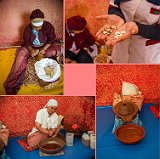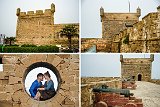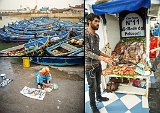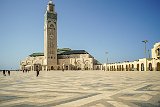
Marrakesh Tour Collage
Somewhere east of the Atlas Mountains I contracted a stomach bug and was miserable during our stay in Marrakesh. The pictures in this collage were taken, mostly when our tour guide pointed out something. Clockwise from top left - 1) Bab Agnaou, one of the 19 gates to Marrakesh, dating from the 12th century. 2) A snake charmer and his cobras in the main square Jemaa el-Fnaa. 3) The Koutoubia Mosque minaret, rising 253 ft and containing a ramp to allow a horse to be ridden to the top for the call to prayer. 4) Water sellers ("guerrab") 5) A white bird of paradise flower growing in our hotel's garden. 6) A small fountain in Parc Lalla Hasna, the western approach to Koutoubia Mosque, and 7) A cell phone tower camouflaged as a tall palm.
Image 1 of 15
Marrakesh Tour Collage

Marrakesh Evening Dinner Collage
Our evening in Marrakesh featured a horse drawn carriage ride to dinner at the Lotus Privilege restaurant. The dinner featured three entertainments: A fire dancer wearing an elaborate candelabra headdress, a pair of Gnawa Musicians, and a belly dancer.
Image 2 of 15
Marrakesh Evening Dinner Collage

Jardin Majorelle Collage
On our second day in Marrakesh we visited the Jardin Majorelle - a two and one half acre garden. The garden was originally designed by French artist Jacques Majorelle between 1920s and 1950s. After he and his wife divorced the gardens fell into disrepair. They were purchased and restored beginning the 1980s by the fashion designers, Yves Saint-Laurent and Pierre Bergé. They were eventually opened to the public. This collage shows various views of the gardens.
Image 3 of 15
Jardin Majorelle Collage

Goats in Trees
On the road from Marrakesh to Essaouira we encountered these tree climbing goats. They climb the squat, wide canopied argan trees which grow in the area. Originally they would go up in the trees during June and July when the fruit ripened, eat the fruit, then expel the undigested pit. These pits were then collected to produce argan oil. Today, particularly for oil used in food, the goat step is bypassed and the pits are extracted manually. While no longer used for argan oil production, the goats are still 'encouraged' to climb the trees during all seasons, particularly along heavily traveled tourist roads, where they are used to extract 'tips' from photographically minded tourists. This occurs whether or not the fruit in the trees are ripe. Argan trees typically take 50 years to mature and produce fruit. After that they will bear an annual crop for another 200 years.
Image 4 of 15
Goats in Trees

Argan Oil Womens Coopérative Marjana
The best argan oil is extracted manually by Berber women in cooperatives. We stopped at the Coopérative Marjana to see the process. This collage shows (clockwise from top left) 1) Cracking the kernel to extract the seeds - a process that has been extremely resistant to mechanization; 2) The cracked kernel shells and extracted seeds. The shells are converted to charcoal and used as fuel. Seeds destined for culinary oil are toasted. Cosmetic oil seeds are processed raw. 3) The basic tools for oil extraction - a rock grinder (known as a R'ha) and an oil extraction bowl. 4) Seed grounds are then mixed with water and hand kneaded to extract the oil. The left over dough-like material (known as Zegmouna) is high in protein and used as animal feed. It takes about 60 lbs of seed to produce 1 quart of oil.
Image 5 of 15
Argan Oil Womens Coopérative Marjana

Essaouira Panorama
Enroute from the Coopérative Marjana we stopped at the Point de Vue Azlef observation deck and viewpoint. From there I took this panoramic view of Essaouira, about 2 1/2 miles away. It is a port city and resort on Morocco’s Atlantic coast. Regarded as one of the best anchorages of the Moroccan coast, the area has been occupied since prehistoric times. About a mile off shore in the distance is Mogador Island. In Roman times this island had a Tyrain (Royal) Purple factory which extracted the dye from the rock snails found near the island's coast. It has now been designated as a nature reserve, and it cannot be visited without official authorization.
Image 6 of 15
Essaouira Panorama

Essaouira's Skala du Port Collage
The original fort at Essaouira was established by the Portuguese in 1506 century. It fell to local resistance 4 years later. The current fort was constructed in the middle of the 18th century by an English renegade known as Ahmed el Inglizi ("Ahmed the English") or Ahmed El Alj ("Ahmed the Renegade"). The harbor is on one side of the fort and the medina/kasbah is on the other. This collage shows the various towers and ramparts with supporting cannon. However as seen in the lower left picture, young lovers find other uses for the fortifications.
Image 7 of 15
Essaouira's Skala du Port Collage

Essaouira Fishing Collage
Historically Essaouira was and still is a fishing village. Its harbor is full of the blue fishing boats and individuals begin selling fish right on the docks - some fresh off the boats, others in more elaborate stalls. Unfortunately my stomach bug made me too ill to go on the tour through the medina and see the established fish market.
Image 8 of 15
Essaouira Fishing Collage

Henna Tattoo Collage
That evening our group went to Riad Dar L'Oussia near an entrance to the old medina. There all the ladies were offered (and accepted) henna tattoos. This is a collage of the event. The upper left picture shows the tattoo artist beginning to prepare her materials - green powdered dried henna leaves, lemon juice, weak tea, and syringes. After mixing the materials and loading them into the syringes she would draw intricate patterns on the ladies hands as shown in the lower left picture. The picture on the right shows all of the results.
Image 9 of 15
Henna Tattoo Collage

Gnawa Musicians
After the Henna Tattoos, we were given a performance by a trio of Gnawa musicians. As one of the westernmost sheltered ports in Africa, Essaouira was a regular port of call for slave ships heading for the Americas. It was common for the ships to dispose here individuals who appeared to be too ill to survive the trip. While many of these did die, many survived as the Gnawa. As a result Sub-Saharan African music were incorporated into Moroccan traditions. In this picture the musician in the center is using a Gimbri, a three string instrument built on a camel skin covered framework. It sounds similar to a bass guitar. The other two are using Krakebs - large iron castanets with a cymbal like sound. The musician on the right also has a tassel on his hat which he was swinging around his head while playing krakebs
Image 10 of 15
Gnawa Musicians

Araucaria Araucana - Monkey Puzzle Tree
Just outside our hotel in Essaouira were these unusual looking trees. They are Araucaria Araucana trees, more popularly known as Monkey Puzzle Trees as an early British observer stated "It would puzzle a monkey to climb that". The name stuck. The tree is actually native to southern Chile and western Argentina. These are young specimens as they are conical. The tree can live over 1000 years. As it matures the lower branches drop away and what remains is a tall (120 ft) trunk topped with sprawling clusters of branches and leaves
Image 11 of 15
Araucaria Araucana - Monkey Puzzle Tree

Notre Dame de Lourdes Collage
Notre Dame de Lourdes is a large Catholic Church in Casablanca. It was built between 1953 and 1956. The collage shows the front, the two massive stained glass windows on either side of the nave and the impressive altar end of the church. Approximately 20,000 Catholics live and are accepted by the majority Muslims in Morocco.
Image 12 of 15
Notre Dame de Lourdes Collage

Mahkamat al-Pasha Collage
Mahkamat al-Pasha, literally "the pasha's courthouse," is an administrative complex serves as a courthouse, residence of the pasha, parliamentary reception hall, and jail. It is unusual in that while it was built in the 1940s, it is built using traditional methods and materials. The reason is simple, the French authorities took modern building materials such as steel and concrete for the war effort. The result is a magnificent traditional Moroccan and Moorish architectural structure. The collage below shows various architectural details as well as the central garden area.
Image 13 of 15
Mahkamat al-Pasha Collage

Hassan II Mosque
The Hassan II Mosque in Casablanca is the largest mosque in Africa, and the 5th largest in the world. Its 689 ft 60 story minaret is the world's tallest. It is topped by by a laser which is directed towards Mecca. A maximum of 105,000 worshippers can gather together for prayer: 25,000 inside the mosque hall and another 80,000 on the mosque's outside ground. The building was begun in 1986 and completed in 1993. Non-Muslims may enter the mosque during non-prayer time as part of a guided tour. Unfortunately our tour did not have enough time planned to let us visit :(.
Image 14 of 15
Hassan II Mosque

Casablanca Panorama From Top of the Kenzi Tower Hotel
Our tour held a farewell dinner at the restaurant at the top of the Kenzi Tower Hotel, where we spent the night. This is a panoramic view towards the west from the restaurant. The Hassan II Mosque is clearly visible 1 1/2 miles in the distance. The Casablanca harbor is the patch of water visible at the right edge of the picture.
Image 15 of 15
Casablanca Panorama From Top of the Kenzi Tower Hotel

